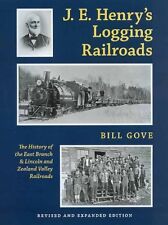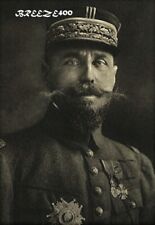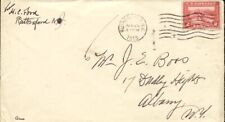When you click on links to various merchants on this site and make a purchase, this can result in this site earning a commission. Affiliate programs and affiliations include, but are not limited to, the eBay Partner Network.
Hello ,J.E. HENRY NEW HAMPSHIRE LOGGER \"MARKING HAMMER\" 15 1/2\" LONG 9 1/4\" WIDE LOGGING KING BUTCHERCombined ship with something else for BIG SAVINGS ON SHIPPING COST !!. Please look at my other items or call me 802-439-6776.THANKS ALOT !!READ MY response PLEASE !! HERE IS A BIT OF INFO ON HENRY - His friends called him Old Ave, but his enemies referred to him as Wood Butcher, Heartless Lumber King, Mutilator of Nature and the Grand Duke of Lincoln. No matter what anyone said, J.E. Henry didn\'t seem to care, since the business of cutting trees was the most important thing in his life. \"I\'ve never seen a tree yet,\" he told a friend, \"that didn\'t mean a damned sight to me going under the saw than it did standing on a mountain.\" From 1880 until 1908, he practiced this philosophy, clearcutting his way across the Zealand and Pemigewasset Valleys, while building a personal fortune valued at $10 million. Ironically, at the same time, Henry — more than any other person — was responsible for the creation of the White Mountain National Forest, a goal he never intended to achieve. In accomplishing this, Henry made more than his share of bitter enemies, some who hated him for his success, and some who despised him for his mean disposition and underhanded tactics. Loggers who worked for him quickly learned that Henry had little time for sentiment. One incident from Ernest Poole\'s \"The Great White Hills of New Hampshire\" illustrates the point. \"And to the widow of a man drowned in the river while loading logs,\" Poole wrote, \"J.E. explained that since the man had not turned in his time that night, he would have to dock him that day\'s pay.\" Henry asked for no favors and he granted none. While adversity defeats some people before they begin, Henry thrived on a challenge and never gave up in the face of tough odds. Born near Littleton in 1828, Henry was a kid from the wrong side of the tracks. The son of a mother who taught school and a father who drove horses, young Henry never enjoyed the life of luxury. During the winter months when walking barefoot to school, he had to fight against the richer boys who teased him and stepped on his shoeless feet. True to his nature, Henry didn\'t take this abuse standing still. \"I licked \'em when I could,\" he recalled, \"and when I couldn\'t, I set my teeth and said, \'You hain\'t agoin to step on my toes always,\' and, by God, they hain\'t.\" When his father lost an eye in an accident, Henry left school at the age of 15 and took over as a horse team driver, a job he carried out for five years transporting freight between Montpelier, Concord and Portland. Though little is known about the next 20 years of his life, Henry did marry Eliza M. Ide, and together they raised two daughters and three sons. After moving to Minnesota and suffering several financial setbacks in land speculation, the Henry family returned to New Hampshire in 1869. That year, Henry focused his sights on logging and never looked back.
For a dozen years, Henry logged in Haverhill and Bath working in a company he owned together with Charles Joy and Alvi Baldwin. Being part owner, however, went contrary to Henry\'s nature. As Ernest Russell wrote in Collier\'s: \"He works best when unrestrained by partners or agents.\" By 1882, Henry had bought them both out and took full control of the business. The stage was then set for the move into Zealand Valley. With the help of his three sons, John, George and Charles, Henry organized the construction of an entire logging camp of the northern head of the Zealand Valley, just to the west of the present day Zealand Campground off U.S. Route 302, west of Bretton Woods. Here they built homes for themselves and the workers, a large saw mill, charcoal kilns, a school and a company store where woodsmen could buy goods from clothing to hardware on credit. Like all other facets of the Henry operation, however, the company store was designed not as a convenience but to make money. Unfortunately, many loggers discovered this only when pay day arrived, and the smart ones planned to do their shopping elsewhere. According to Robert Pike, the author of \"Tall Trees, Tough Men,\" Henry may have overcharged his customers from time to time. When one logger lined up to receive his wages, Henry told him that he had run up a substantial bill: \"Ten dollars deducted for the tobacco you bought in the wangan (company store) last winter,\" Henry said. \"But Mr. Henry, I never use tobacco,\" the man replied. \"Ask any of the men. They\'ll tell you.\"
\"Can\'t help it,\" Henry answered. \"It was there for you if you wanted it. Next man.\"
To better harvest the rich forests of the Zealand Valley, Henry built a crude and twisting railroad from his Zealand settlement through the valley with branches reaching as far south as Ethan and Shoal Ponds. Aside from speeding the process of their harvesting, this makeshift railroad line provided a direct link with the Concord and Montreal Railroad whose tracks passed through the heart of Zealand village.
Every man who worked for Henry in his Zealand Valley days had to aoffere a list of regulations governing everything from the way to cut and fell trees, to conversation at the dinner table. Each infraction resulted in a fine, and those who continued to break the rules lost their jobs.
Oddly enough, 28 of the 47 posted rules at Zealand and every camp within the logging operation concerned the care and treatment of horses, animals vital to any successful timber outfit. Rule 5 — \"Do not feed the horses on the ground, but have boxes for them,\" and Rule 12 — \"Do not tie a horse with either strap of rope around his neck\" — illustrate the care Henry expected of each of his prized animals.
Having a crew of 250 men in the winter months, with 80 full-time employees in the summer, Henry directed one of the largest and most efficient logging companies in New England.
Still, when cutting in the Zealand Valley, Henry began by harvesting only the bigger trees, 10 inches in diameter or more, leaving the smaller spruce and fir behind. Unfortunately, the result of this policy — to Henry\'s mind — only caused trouble.
His later zeal for clearcutting,\" the late C. Francis Belcher wrote in \"Logging Railroads of the White Mountains,\" \"may have come from the experience of seeing a violent and costly forest fire in 1886 consume what he had conservatively left on these stumps under 10 inches. However, this fire was probably helped along by the slash he had left from his earlier cutting.\"
Though Henry survived the fire and continued to log in the Zealand Valley, he realized that those forests couldn\'t sustain his mills forever.
During the nest few years after the fire, he explored the woods of the Pemigewasset and gradually acquired title to tracts of land through a series of skillful deals. Even though the Zealand Valley logging was carried on until the mill burned in 1897, Henry transferred most of his equipment, men and all of his family to Lincoln in August 1892.
Here, in short order, he carved another mill town from an area that was — with the exception of a few scattered homes — a wilderness.
Four months after arriving, his 100-man construction force had erected six houses, another company store, a blacksmith shop and a barn. By the following spring, the settlement was linked up by railroad with the Concord and Montreal tracks in North Woodstock, and by the end of the summer, a mill was churning out 100,000 board feet of timber a day. If Henry had a gift for anything, it was efficiency.
Pike points out that Henry had originally intended to cut all the available saw timber in the Pemigewasset and then move on, but Henry\'s wife persuaded him to settle permanently at Lincoln. In addition, Henry\'s three sons were interested in expanding the family\'s business to include a pulp mill (1902).
By comparison with working conditions at Zealand, the life at Henry\'s Lincoln camps seem far more modern and lenient.
He offered workers health insurance — at 50 cents a month — and constructed a hospital to treat the injured. Every Christmas, loggers and their families received turkeys and food baskets courtesy of the Henrys. Even the physical condition of the camps improved. The dark, dingy hovels used at Zealand were replaced with new portable buildings complete with framed glass windows — more spacious, clean and weather-proof than past models.
Despite the increased attention Henry paid to improved working comforts, he wasn\'t mellowing with age. Having celebrated his 60th birthday, before moving to Lincoln, Henry maintained his practice of working from sunup to sundown, and he expected the same of his employees.
What Henry accomplished in the Pemigewasset, in terms of logging efficiency, was the model for its day. Using as many as six to eight locomotives at a time, his trains hauled an average of 3- to 3-1/2 thousand board feet of lumber each run. The tracks themselves, running on well-graded beds and over sturdy trestles were a vast improvement over the Zealand lines; proof of the soundness of the lines and the logging roads can be found today in the remaining roads and lines which serve as hiking paths.
Attached as he was to hard work and the strenuous life, Henry finally decided to retire from active participation in the company in 1908. He willed his property, valued at an estimated $10 million, to his three sons, and for the next four years until his death in 1912, he lived quietly in the palatial home he had constructed in the center of Lincoln.
In looking back on Henry\'s logging career, Fran Belcher cautioned present day critics to evaluate Henry according to the standards of his time, and not ours.
\"In 1900,\" Belcher wrote, \"the infant science of forestry knew few methods. It took the Henrys of that day to develop the science of forestry of the present, even if by a negative example.\"
Today, Henry is remembered more for his overpowering work ethic and his devastatingly efficient timber operations. Few know that he contributed thousands of dollars to the Morgan Memorial of Boston, Goodwill Industries of America — and, judging by Henry\'s character, he probably preferred it that way.
After all, he believed in work, and in the work of logging, above all else. As one of his workers recalled, nothing in Henry\'s life was more important.
\"One winter I slipped off an icy ledge and struck down into a tree below. It bruised me some but I got up and by working my compass got down to Lincoln just after dark. The lighted mills were still going full blast. When I went into the office, still kind of bloody from my fall, J.E. gave me a sour look.
\"\'Quit kind of early, didn\'t you?\' he said.\"
I AM SORRY FOR THE FUZZY THING ON MY PICS. THERE IS SOMETHING ON THE CAMERA LENS !!









